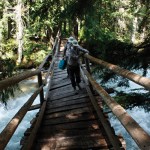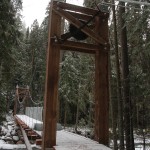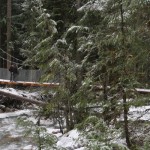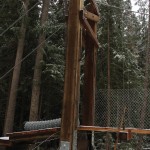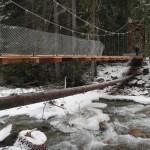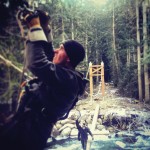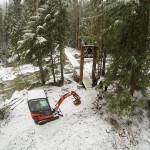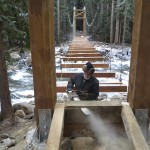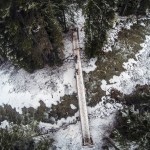By: Laura Keil
Work on a new suspension bridge across Swift Creek is nearly completed, and will connect the approved bike trail system this spring.
The new 80-foot bridge replaces an older log bridge that was badly damaged during high water two years ago.
The bike trails Master Plan Phase 1 was approved by the Province in March 2014. The project is managed by the Valemount Area Recreation Development Association (VARDA); the non-profit is working in cooperation with Rec Sites and Trails BC.
VARDA General Manager Curtis Pawliuk says they have received funds from Northern Development Initiative Trust, Columbia Basin Trust and YORA for work on the bridge which cost just over $70,000.
Robson Energy Services (Andreas Thoni) and G. Carson Logging (Gordon Carson) were the contractors, and the pair used inventive methods of getting in supplies to the bridge to avoid the need to build a road through sensitive ecosystems.
Carson set up a high-lead system for moving the larger pieces of wood like the 16-foot support beams. A high-lead system uses pulleys and wire so the logs don’t touch the ground, eliminating much of the disturbance.
Pawliuk says he is very proud of the efforts the contractors took to minimize environmental impact.
Thoni says they also sourced locally as much as possible. Some of the cedar deck was harvested by the Community Forest and was milled by Carson. They also used local equipment and contractors.
He says the suspension-style was chosen because of the remote location and the span of the creek.
Additional funding from the National Trails Coalition means VARDA has about half the money it needs to complete the trail work for Phase 1, which is estimated to be $160,000. Currently, the group has $70,000 for trail work.
Phase 1 will include the Swift Creek Southern Traverse, the Swift Creek Northern Extension, one of the climbing trails (also used as a cross-country trail) and one intermediate downhill trail, Pawliuk says.
The current Swift Creek Trail, as people know it now, will be widened, and portions of it moved to higher, drier ground. While mountain bikers now have to fend off numerous tree roots and other hazards, the new trail will be evened out.
Pawliuk says VARDA, the Yellowhead Outdoor Recreation Assoc. (YORA) and the info centre get a lot of phone calls from people interested in coming here to mountain bike.
“We had nothing to offer except the Swift Creek Trail. With Phase 1, it’s enough for two days of mountain biking,” Pawliuk says. “It will give us the opportunity to say you can come here.”
He says in addition to it being a marketable product, it also gives locals another opportunity to get outdoors.
He says new trail system design focuses on flow – there is little interruption, and it flows with the terrain. Old-style trails were often built on the fall line; they followed the path of least resistance, and you were not using the land to its full extent.
The bridge is named after Slim Lebans who operated a mill close to the bridge site. There are still old sawdust piles, proof of the logging done in the 1950s. Luckily, the loggers left many of the very old cedars intact – some of them 4-5 feet across.
Thoni says part of the beauty of the Swift Creek Trail is the way it traverses many environments – from the lush moss and ancient cedar trees on the south side of the creek to the sand and pine trees on the north.
They are not quite done – they still have to complete the ramps to the bridge, so Thoni warns there won’t be public access until spring.
There are four phases to the Master Plan. Other phases include just under 40 km of trails and a skills park. Daniel Scott, trail specialist from the International Mountain Bike Association, spent 10 days in June 2012 surveying the area to help create the Master Plan.



